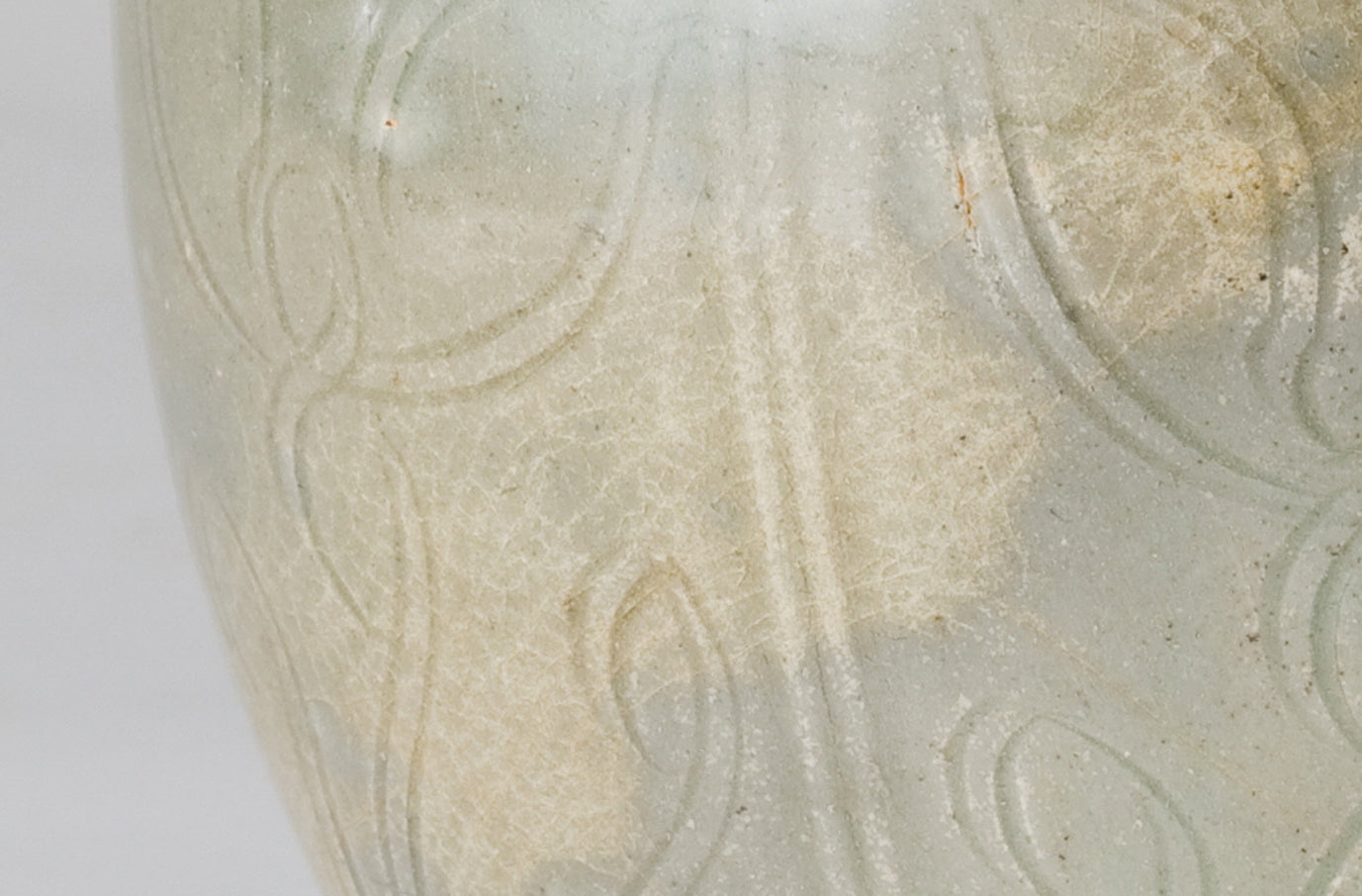AUA Oriental Art
Celadon Vase, Five Dynasties or Northern Song dynasty, 10th-11th Century
Celadon Vase, Five Dynasties or Northern Song dynasty, 10th-11th Century
Couldn't load pickup availability
The form of Longquan celadon vases from the Northern Song dynasty evolved from an early design with a long neck and tapering body to a later ovoid body with a shorter neck. Over time, the glaze developed a more olive tone, and the carved decorations became more pronounced and intricate. Examples of such vases include one without a cover dated to the Yuanfeng era (1078-1085) and documented in literature, and another similar vase without loop handles preserved by the Qingyuan County Cultural Relics Bureau. An earlier example featuring loop handles and a lotus-like cover is also mentioned in historical texts.
The use of Longquan covered vases, especially as funerary jars for offerings like wine and grains, was highlighted by an inscription on a piece from the Sir Percival David Collection, London. This inscription wishes for the vessel to preserve fragrant wine for centuries, blessing the owner with prosperity, longevity, and a vast lineage, dated to the third year of the Yuanfeng period (1080). This practice was common in the regions of Southern Zhejiang and Northern Fujian. A similar celadon vase from the Linyushanren collection was auctioned at Christie’s Hong Kong, emphasizing the cultural and historical significance of these artifacts.
Period : Five Dynasties or Northern Song Dynasty
Type : Celadon, Zhejiang province
Medium : Celadon
Size : 31.5 cm(Height) x 11.5(Diameter)
Provenance : Acquired in lates 1990s from Hongkong
Reference :
1) The British Museum image id - 01613270570
https://www.bmimages.com/preview.asp?image=01613270570
2) Christies New York 23–24 MAR 2023 - Important Chinese Ceramics and Works of Art - Lot 1012
(Price Range : USD 18,000 – USD 25,000 / Type : Related)
https://www.christies.com/en/lot/lot-6413770
3) National Gallery of Victoria - Accession Number - AS5-1973
https://www.ngv.vic.gov.au/explore/collection/work/52934/
* Celadon from Five Dynasties (907-960) to the early Northern Song Dynasty (960-1127)
The period from the Five Dynasties (907-960) to the early Northern Song Dynasty (960-1127) marked a significant transitional phase in the development of Chinese celadon ceramics. During this era, celadon underwent considerable advancements both technically and artistically, securing its place as one of the most important genres of ancient Chinese pottery.
Technical Advancements
- Glaze Innovation: There was a notable evolution in celadon glaze technology during this period. The glazes became richer and more varied in color, ranging from celadon's signature bluish-green to olive green tones. - High-Temperature Firing: Improvements in firing techniques at high temperatures enhanced the quality of the products. This allowed the glaze to bond better with the body, resulting in a more durable and lustrous surface.
Artistic Development
- Forms and Design: Early celadon pieces evolved from simple shapes to more complex and refined designs. A variety of items, including vases, jars, and bowls, were produced, with surface decorations becoming increasingly diverse.
- Carved Decorations: This period saw the addition of carved decorations on celadon wares, featuring motifs of plants, animals, and geometric patterns. These decorations further accentuated the beauty of celadon ceramics.
Regional Characteristics
- Importance of Location: The main production area for celadon during this era was the Longquan region in Zhejiang Province. Longquan celadon became renowned for its distinctive color and quality, exerting a significant influence on later generations.
Cultural Impact
- Popularity at Home and Abroad: Early celadon was highly popular not only within China but also internationally. It was exported to Southeast Asia, the Middle East, and even Africa.
- Symbol of Social Status: High-quality celadon was favored among the nobility and upper classes, serving as a symbol of social status during this time.
These advancements during the transition from the Five Dynasties to the early Northern Song Dynasty played a crucial role in establishing Chinese celadon as one of the world-renowned categories of ceramics.
Share


















